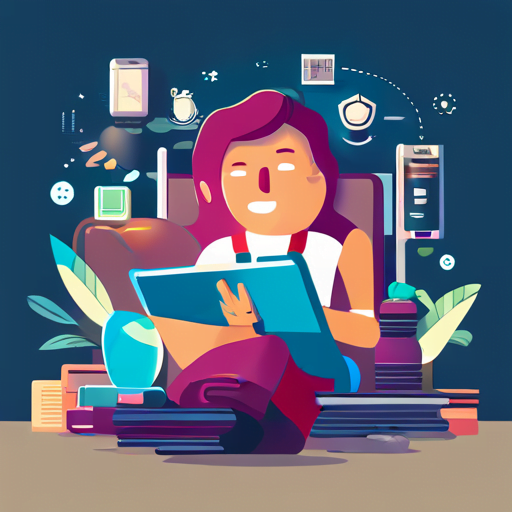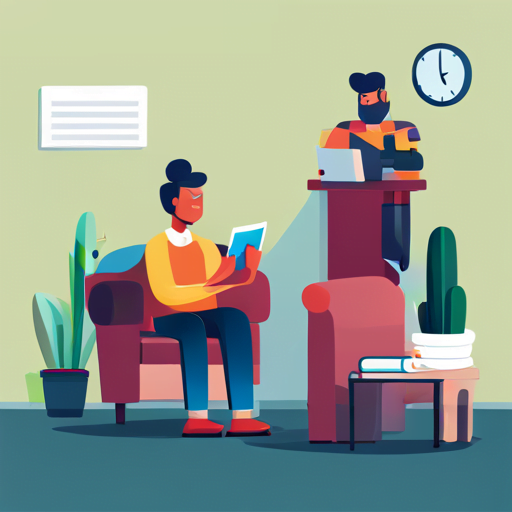If you’re a parent, you’ve likely heard the debate over screen time and e-reading. Some argue that too much screen time can lead to negative effects on children’s development, while others argue that e-reading can have numerous educational benefits.
With so many conflicting opinions, it can be difficult to know what’s best for your child.
On one hand, studies have shown that excessive screen time can lead to issues such as decreased attention span, poor sleep, and even obesity. Additionally, some experts argue that e-reading can disrupt the traditional reading experience and hinder comprehension.
However, others argue that e-reading can actually improve reading skills and make reading more accessible to children who struggle with traditional print.
So, what’s the truth? It’s important to examine the current research and find a balance that works for your family.
Table of Contents
The Negative Effects of Screen Time and E-Reading

You can feel your eyes getting strained and your mind becoming overwhelmed when you spend too much time staring at digital devices and books on a screen. This is because the blue light emitted by the screens can interfere with your sleep patterns, making it difficult for you to fall asleep at night.
Additionally, reading on a screen can lead to a decrease in reading comprehension and retention compared to reading from a physical book. Furthermore, excessive screen time can also lead to physical health problems, such as headaches, neck pain, and eye strain.
This is because when you stare at a screen for an extended period, your eyes have to work harder to focus and follow the text. In addition, prolonged sitting in front of a screen can lead to poor posture and back pain, which can have long-term consequences on your overall health and wellbeing.
In conclusion, while digital devices and e-reading have revolutionized the way we access information and entertainment, it’s important to be mindful of the negative effects of excessive screen time. To minimize the negative impact on your health and wellbeing, it’s recommended that you take frequent breaks, adjust the screen brightness, and limit your overall screen time. By doing so, you can enjoy the benefits of digital devices and e-reading without compromising your health and wellbeing.
The Benefits of Screen Time and E-Reading

Now, let’s talk about how using screens and reading digitally can actually be pretty great for you!
For starters, e-reading can be a convenient and cost-effective way to access a vast library of books. With just a few clicks, you can have access to thousands of titles without leaving your home. Plus, many e-readers have built-in features such as dictionary look-up and note-taking that can enhance the reading experience.
Screen time can also have its benefits. For instance, video games can improve cognitive function, problem-solving skills, and even hand-eye coordination. Additionally, educational apps and programs can be a fun and engaging way to learn new skills or reinforce concepts learned in school.
Plus, with the rise of remote work and online education, screen time has become an essential tool for communication and productivity.
Of course, like anything else, moderation is key. Too much screen time can have negative effects on physical and mental health, and it’s important to take breaks and engage in other activities. But when used in balance, screens and e-reading can provide many benefits and enrich our lives in countless ways.
So, next time you’re feeling guilty about spending time on your phone or tablet, remember that there can be some real advantages to digital technology.
Current Research on Screen Time and E-Reading

You may be interested to know that current research on screen time and e-reading covers three key areas.
Studies on children and adolescents have shown that excessive screen time can lead to negative effects on cognitive development and social skills.
On the other hand, studies on adults have found that e-reading can have positive effects on cognitive function and mental health.
Finally, research on the long-term effects of screen time and e-reading is still ongoing, but early findings suggest that moderation is key to avoiding negative consequences.
Studies on Children and Adolescents
Hey, parents and caregivers, when your kids have access to electronic devices, it’s important to know how they’re affecting their development and behavior.
Studies have shown that excessive screen time can lead to a variety of negative outcomes for children and adolescents. One study found that children who spent more than two hours a day on electronic devices had lower language and cognitive development scores than those who spent less time. Another study found that excessive screen time was associated with increased risk of depression and anxiety in adolescents.
However, not all studies have found negative effects of screen time on children and adolescents. Some studies have found that moderate e-reading can actually improve literacy and cognitive skills in children.
Additionally, the American Academy of Pediatrics now recommends that children ages 2-5 be limited to one hour of screen time per day, and children ages 6 and older be limited to consistent limits on the amount of time spent on electronic devices.
So, while it’s important to be mindful of the amount of time your child spends on electronic devices, it’s also important to consider the content and purpose of their screen time.
Studies on Adults
If you’re an adult who spends hours on end staring at electronic screens, you might want to consider the potential negative effects on your mental and physical health.
Studies have found that excessive screen time can lead to eye strain, headaches, and neck and shoulder pain. In addition, the blue light emitted by electronic devices can disrupt your sleep patterns, making it harder to fall asleep and stay asleep throughout the night.
But it’s not just physical health that can be affected by too much screen time. Research has also linked excessive electronic device use with depression, anxiety, and decreased cognitive function.
It’s important to be mindful of the amount of time you spend in front of screens and to take breaks as needed to give your eyes and brain a rest. So, if you’re someone who spends a lot of time on your phone, tablet, or computer, be aware of the potential negative effects and take steps to reduce your screen time for the sake of your overall well-being.
Long-term Effects
The potential long-term effects of excessive screen time on mental and physical health are a concern that shouldn’t be ignored.
Studies have shown that prolonged screen time can lead to eye strain, headaches, and neck and shoulder pain. Additionally, excessive screen time can disrupt sleep patterns, which can have negative effects on overall health and well-being.
Furthermore, some studies suggest that excessive screen time may be linked to increased rates of depression and anxiety. However, these studies are still in the early stages, and more research is needed to fully understand the long-term effects of screen time on mental health.
In the meantime, it’s recommended to practice moderation when it comes to screen time and to take breaks frequently to reduce the risk of negative effects.
Finding a Balance

To strike a healthy balance between technology and other activities, you may want to consider setting specific time limits for screen use and incorporating a variety of offline hobbies and interests into your daily routine.
This way, you can ensure that you’re not spending too much time in front of a screen and neglecting other important aspects of your life. Setting a schedule and sticking to it can also help you establish a healthy routine and prevent the temptation to constantly check your phone or computer.
It’s important to remember that technology can be a valuable tool for learning, connecting with others, and staying informed. However, it’s equally important to make time for other activities that can improve your physical and mental well-being.
This could include anything from reading a book, going for a walk, or practicing a hobby that you enjoy. By finding a balance between screen time and other activities, you can set yourself up for a more fulfilling and well-rounded life.
Incorporating offline activities into your daily routine can also help you avoid the negative effects of excessive screen time, such as eye strain, poor posture, and disrupted sleep patterns.
By taking breaks from technology throughout the day, you can give your mind and body a chance to relax and recharge. Ultimately, finding a balance between screen time and other activities is about prioritizing your overall health and well-being, and making intentional choices about how you spend your time.
Frequently Asked Questions
How can parents limit their children’s screen time and e-reading without causing conflict?
As a parent, you may be wondering how to limit your child’s screen time and e-reading without causing conflict. It can be challenging to find a balance between allowing your child to engage with technology and ensuring they don’t spend too much time in front of a screen.
One approach is to set clear boundaries and establish a routine. For example, you might limit screen time to certain hours of the day or require that your child complete their homework or chores before using electronic devices.
It’s also important to provide alternative activities, such as outdoor play or reading physical books, to encourage a healthy balance of screen time and other forms of engagement.
Remember, open communication and setting expectations can go a long way in preventing conflict and promoting a healthy relationship with technology.
Is there a difference in the negative effects of screen time and e-reading on different age groups?
Are you wondering if there’s a difference in the negative effects of screen time and e-reading on different age groups?
Studies have shown that the effects of screen time and e-reading can vary depending on age.
For younger children, excessive screen time can lead to developmental delays and behavioral issues, while e-reading can have a positive impact on their literacy skills.
However, for older children and teenagers, excessive screen time can lead to sleep problems, mental health issues, and decreased academic performance.
It’s important for parents to monitor their children’s screen time and e-reading habits, and to set limits that are appropriate for their age and developmental stage.
Can screen time and e-reading be beneficial for individuals with certain learning disabilities?
If you or someone you know has a learning disability, you may be wondering if screen time and e-reading could be beneficial. The answer is yes!
Some individuals with dyslexia or other reading difficulties find that e-readers with adjustable fonts and spacing can make reading easier and more enjoyable.
Additionally, certain educational apps and games can help improve cognitive skills, such as memory and attention.
However, it’s important to consult with a healthcare professional to determine the best approach for each individual’s unique needs.
How can educators incorporate screen time and e-reading into their lesson plans effectively?
To effectively incorporate screen time and e-reading into your lesson plans, start by considering your students’ individual needs and learning styles.
Introduce technology gradually and purposefully, using a variety of tools and resources to keep students engaged and motivated.
Encourage active participation and collaboration through online discussions, interactive games, and multimedia presentations.
Provide clear guidelines and expectations for responsible technology use, and monitor students’ progress and feedback regularly.
By integrating screen time and e-reading into your teaching, you can enhance your students’ learning experience and prepare them for the digital world ahead.
Are there any long-term effects of excessive screen time and e-reading on mental health?
Excessive screen time and e-reading can have long-term effects on your mental health. Studies have shown that spending too much time in front of screens can lead to depression, anxiety, and sleep problems.
This is because the blue light emitted from screens can disrupt your circadian rhythm, making it harder to fall asleep and stay asleep. Additionally, excessive screen time can lead to social isolation and a lack of physical activity, both of which can contribute to poor mental health.
It’s important to find a balance between screen time and other activities, and to take breaks throughout the day to rest your mind and eyes.
Conclusion
So, there you have it – the debate over screen time and e-reading. While there are certainly negative effects associated with excessive screen time and e-reading, it’s important to remember that there are also many benefits to these activities. And, as with most things in life, the key is finding a balance that works for you and your family.
Current research suggests that limiting screen time and encouraging offline activities is important for children’s development, but this doesn’t mean that all screen time is bad. In fact, when used in moderation, screens can provide valuable educational and entertainment opportunities.
The bottom line is that there is no one-size-fits-all answer when it comes to screen time and e-reading – it’s up to each individual to find the right balance for themselves and their family.
